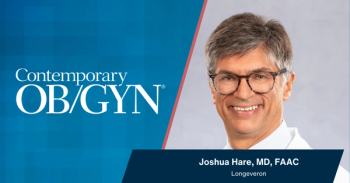
New Developments in IVF
OBGYN.net Conference CoverageFrom First Congress on Controversies in Obstetrics, Gynecology & Infertility Prague CZECH REPUBLIC - October, 1999
Dr. Mark Perloe: "I'm here with Michael Tucker who is well-known for his work in embryology and is one of the leaders in IVF laboratory work. I've been excited about all the new advances that seemed to develop and pop up over the past year. Now maybe I'm a little naive in seeing these as appearing all at once - I know there's a lot of work that's gone into getting there. Can you share with us some of the things that you've been excited about?"
Dr. Michael Tucker: "True, it seems to me every year brings new developments, and certainly in the last year or so there have been some which have been fairly notable. The move toward extended culture in human IVF is certainly something that I'm very happy to see. It allows us to transfer embryos at a later stage of development - at the blastocyst stage, thereby allowing us to discriminate more accurately as to which embryos have greater potential viability. The consequences of this allow us to transfer fewer embryos. I think there's been a dire need to move away from three or four embryos or sometimes even more at embryo transfer in human IVF, and to move away from that as routine to the placement of, say, just two embryos at the blastocyst stage and reduce the potential for multiple implantations. I think, ultimately, certain forms of embryo screening will allow us to maybe screen for using metabolic probes to get an even better handle on embryo viability. Potentially, it will bring us sometime in the next few years to single-embryo transfers, which I think will be the ultimate aim for ourselves and ART. So the shift of the extending culture in human IVF has been very exciting. From my perspective as an embryologist, it's a great privilege; it allows us to extend the period during which time we can actually observe the growth of the early human pre-implantation embryo. This is a great privilege in the IVF lab, but beyond that probably one other area which is of great interest to me is actually cryopreservation - the freezing of tissue. Although it has not been held in any great way, we've started to see a greater level of consistency in human egg freezing, bringing us to the point where now I could probably safely say that mature human eggs could be routinely frozen with a good 60% survival. This may not sound so exciting, but the problems which have existed prior to this point have allowed us to get good survival in one patient and in another we get very poor survival after thawing the eggs. This inconsistency has been smoothed out so that across the board we should be much more confident about offering routine mature human egg freezing as a regular service, and that's of great comfort to me. Of course, in the news recently has been the first potential inroads into freezing of ovarian tissue. This clearly allows for the potential to take tissue from the ovary of a woman about to undergo some kind of cancer therapy and essentially put her reproductive potential on ice, and following fully that at some point in the future allows this tissue to be transferred back to the woman, to institute cyclicity in that woman but also with the potential to make her reproductively capable into the future. Now, this side of the technology is not quite so interesting to me. I'm much more enthusiastic to take the in vitro route; that is, to actually take the tissue and grow it out for sometimes several weeks - maybe five, six weeks - with human ovarian tissue to actually take primordial follicles all the way out to the mature egg stage. That would be, I think, one of the greatest challenges, as I see it, in the ART labs of the future. Whether it's doable or not remains to be seen, but it's one heck of a challenge which I'd certainly like to be involved in over the coming years. Those are some of the things that grabbed my attention in the last year or so."
Dr. Mark Perloe: "The issues of dealing with the immature ovocyte, whether it's a cryopreserved primordial follicle or one that's retrieved in a woman who's not undergone drug stimulation, I think is a real challenge. A few years ago there was a paper where they were transferring these follicles to mice whose immune systems had been ablated. Have you seen that work continue in mouse models, or do you think we're going to move to a pure in vitro model for maturing immature eggs?"
Dr. Michael Tucker: "I think you know that the problems with complete maturation in vitro from primordial follicle stage all the way to the antral follicle stage with new eggs is that there are several stages which need to be focused upon. Each stage of development has it's own requirements, nutritionally and tissue culture-wise. The utilization of the new mass to maybe transfer tissue into a lab animal, giving a sort of in vivo environment to develop the follicles, is a neat - how can I say - a neat system, but I think ultimately it needs to be overcome. It's enabling the animal to carry the development of the follicles as a stopgap, as it were, for the inadequacies of what we currently provide in vitro. I think the problem with that technique - although it allows us to explore further the ability to develop those follicles, at least observed in the males - the problem with that is that there's some inherent reluctance to take that course, certainly for clinical use. But certainly that improves our ability to at least examine development through that stage."
Dr. Mark Perloe: "So it may be a good model for testing our capability of freezing these follicles or preserving them and then looking at what they do, but long-range clinically, we'll have to bypass that and be able to replace what's precise now. You brought up an interesting point about the nutritional aspects of the egg from the stage of an immature follicle to the time for ovulation. Analagous changes come about in embryo culture that have allowed us to proceed to the blastocyst stage. Could you tell us a bit more about some of those changes, and what's happening in the lab now that we can do this?"
Dr. Michael Tucker: "Just as a sort of micro view of the weeks that will be required for ovarian tissue development, it's interesting that the compression of those five or six phases' extended culture from the human embryos has taken us this long to achieve some analysis of the requirements from one day to the next. I certainly can't claim to be at the forefront of developing that. There's been some good basic science applied by some basically reproductive physiologists into the nutritional requirements of the early human embryo, and in that regard, there are probably three distinct phases which have been dissected. First are the requirements necessary for in vitro fertilization to occur. What seems to be optimal to allow sperm to attach and fuse with the human egg and fertilize it is the first stage requiring one form of medium, principally with a good energy source with some glucose kicking around. But secondly, the development stage from the zygote from the one cell pronucleate embryo through to the cleavage stage is the next phase. This is the phase that we're most comfortable with because that's the period in which we've been observing early development for the last ten, fifteen years or more. It's been interesting that many of the cultural media that we've used routinely over the years have amusingly or frustratingly been inadequate, in as much as they've provided the wrong nutritional sources for the early embryo, or at least the wrong balance of those nutritional elements. That's been resolved to some extent now by using low glucose or no glucose in early stage development with the removal of phosphates. This seems to improve the consistency of the early cleavage stage embryo with the provision, then, that as the embryonic genome kicks in around the eight cell stage in the human embryo, the nutritional requirements shift to the next stages of development through day three to day five, day six and the blastocyst development where, again, glucose reappears as a major source of energy. The dissection of which amino acids seem to be a benefit amongst the essential and non-essential amino acids has been interesting as we've moved away from just-off-the-shelf tissue culture media, which have been developed historically for totally different somatic cell growth. Those media have been largely replaced with much more specifically designed blastocyst growth media with which I feel much more confident after years of only really having confidence with co-culture as a means to allow us to routinely grow out blastocysts. Now, to see that we have much more fully defined media which can routinely take embryos out to the blastocyst stage at a good 50% rate of all fertilized eggs is something which I think is to be noted and applauded."
Dr. Mark Perloe: "This technology is obviously in place, and there've been dramatic improvements in pregnancy rates in the bigger, more experienced, well-run laboratories. Do you think that this technology is trickling down to the point where patients across the board can expect to find improvements wherever they go? Do you think that the media is, in a way, making up for labs that may not have been up to par in the past?"
Dr. Michael Tucker: "I think IVF is really a team effort. It would be incorrect to focus on one element, such as the culture media, in isolation from every other element of the IVF program. At least as far as the tissue culture side of IVF is concerned, the consistency and the culture medium is now there where it wasn't previously, but there are a bunch of different elements that you need to apply to human IVF to make it work. I think, inevitably, there's a trickle down throughout the programs throughout the U.S. I think you'll see overall improvements in consistency, but I think these have gone hand-in-hand not just with culture media, but also in improved investigation of each individual embryo as it grows. The analysis of the pronucleus status of the embryos is certainly of note. Instead of just saying, 'yes, there are two pronuclei here,' actually defining sizes of pronuclei, the nucleoli elements within those, and how that relates to potential embryo quality has been exposed much more over the last year or so, as have the inadequacies of screening at the two to three day stage of development. At the cleavage stage, we're starting to discern that many of the factors that we thought were important morphologically are not so, now that fragmentation and later development up to day three is not always necessarily correlated with blastocyst formation. Indeed, in a study that we undertook recently in a program I'm involved with in Rockford, Maryland, we actually individually cultured embryos in over one hundred cycles to observe embryos that we would have selected on day three of development and correlated that with ultimate utilization on day five and day six. To our great surprise, it was actually only 50% of the embryos that we had assumed, based on morphological assessment on day three, ended up being the ones that were ultimately utilized for freezing or fresh transfer at the blastocyst stage on day five and day six. A fairly embarrassing testament."
Dr. Mark Perloe: "So we're still not too good at picking out on day three which embryos are going to do well by day five."
Dr. Michael Tucker: "No. Clearly, we've compensated for that in the past by throwing back more embryos into the uterus. It's an acknowledgment of our inability to choose, or at least we weren't aware of that - we just simply thought that we were making more embryos, which were of lesser viability on day three. The reality was that we were miscalculating which ones were the viable embryos. So it's been fairly ironic, to say the least, and I think that helps define why blastocyst development and transfers are so very essential to reducing the number of embryos that we transfer, but improving the implantation potential of each embryo we put back. Another area in which I've been involved fairly routinely for several years now has been pre-implantation and genetic diagnoses. I helped out in one of the first collaborative studies which actually showed a benefit from the day three embryo biopsy, first by taking out one or two cells from a day three embryo and then analyzing it for chromosomal content. Then we transferred those embryos on the basis of that screening versus what we had done traditionally, which was to discriminate embryos on day three based on their morphology. In a head-to-head study, they actually showed not an improvement in initial pregnancy rates relative to whether we put back chromosomally screened embryos versus morphologically chosen embryos, but ultimately the implantation rates and delivery pregnancy rates were higher in the aneuploidy, chromosomally-screened embryos. This is the first study ever to do that. But the problem was that that screening was all undertaken on day three, and what appears to be the case is that a fairly hefty number of aneuploidies, especially monosomics, which drop out during the compaction and morulus stage, day three through day five. So in essence, the simple expedient of growing out embryos to day five or day six, you actually passively screening out the…"
Dr. Mark Perloe: "You may not apply this type..."
Dr. Michael Tucker: "Yes exactly, so you know this is clearly another benefit of extended culture."
Dr. Mark Perloe: "Do you see that there are two prominent routes of testing? Obviously, the fluorescent studies... There is a device to screen for the common aneuploidies and then also using PCR to pick up specific gene anomalies. Do you see those as complimentary techniques, or that one may be rushing to the forefront more than the other, or are we going to try to look at chromosomal spreads on a couple of cells that we pick up? Where do you see the direction or even biochemical testing?"
Dr. Michael Tucker: "I think those developments will run hand-in-hand. I think FISH technology first in situ hybridization screening for individual chromosomes will become much more routine. I see the turn-around time on these tests has improved enormously, and the ability to recycle tissue even if it's only one or two nuclei for both FISH and for PCR is there currently. I see the potential for that tissue to be maximized in its screening potential through both FISH and PCR technologies in the future, particularly if we move to the biopsy of the trophectoderm that is non-embryonic material from the blastocyst. While that reduces the amount of time you might necessarily have for the screen using either of those technologies, the fact of the matter is that the turn-around time on the test is much faster now than it was even three or four years ago. Taking several cells - maybe five or ten- from the trophectoderm will not only increase the amount of material you have to analyze, but will allow you to piggyback many of these tests within a matter of hours. This allows one to get some very clear screens, not only on chromosomal status and point genetic mutations, but also to actually get an actual DNA fingerprint on the embryo itself. In a sense, given the potential parents of that embryo, we can actually have the ultimate say on whether that embryo belongs - as it were, 'is destined' - to go back into that particular couple. So yes, you can have a DNA fingerprint and say, 'this is your embryo.' They're happy not only that it's chromosomally normal and genetically normal, but that it's also destined to be transferred to you. Those technologies are definitely out there."
Dr. Mark Perloe: "I know we've seen reports about this being applied in specific cases where there are risks. Are any programs doing this on a routine basis, or offering it on a routine basis, and how far away do you think we may be from routine aneuploidy screening?"
Dr. Michael Tucker: "I would say probably in the next four to five years it will become not just something which is dabbled in at one or two of the major centers in the states, but I think that it will become more routinely accessible to clinics in general. I think what that's going to take is an improved comfort level with extended culture, and that's only just beginning to happen. Just as we saw the introduction of ICSI in 1992-1993, it probably took five to six years before everyone became truly comfortable with the technology, so that at a meeting like this here in Prague, you can actually go in and see all the issues about ICSI - should it or shouldn't it be done being dissected? Basically, the answer now is that ICSI is so routine, it's almost interchangeable with conventional IVF. That's amusing to me when I look back five or six years ago, the agonizing that went on over whether that technique should have been applied or not. These things are evolutionary, I would say there needs to be a comfort level both with blastocyst culture becoming routine and, secondly, with people's abilities with micro-manipulation to routinely biopsy these embryos. Certainly at the cleavage stage to pop out a cell or two to retrieve the nucleus has never become as consistent or comfortable a technique as perhaps ICSI. Certainly its consistency has never reached the level of the application of ICSI. However, trophectodermal biopsy where you're not dealing with the embryonic tissue itself, where you're actually scavenging several cells from the non-embryonic tissue, I think, is a less exacting procedure, and therefore will probably appeal to a broader group of embryologists who will say, 'yes we can do this.'"
Dr. Mark Perloe: "So you run the risk that trophectoderm may not represent what's going on genetically inside the embryo."
Dr. Michael Tucker: "Currently there has been a hypothesis that the trophectoderm, in essence, was like a trash can, particularly in terms of mosaicism. In many cases a lot of the abnormal cell lines from the early differentiation of cells in the embryo, that high rate of chromosomal abnormality, would be picked up in the trofectoderm because it was basically the dumping ground, as it were, for those cells, and thereby screening the trofectoderm would give you a poor read on the embryo itself. That has not actually proven to be the case, and in fact, actually, it's given in the one specific area of chromosomal aneuploidy screening. It actually doesn't seem to be born out. So I don't think..."
Dr. Mark Perloe: "The CVS literature, chorionic villi sampling... I know the early literature suggests that there were some discrepancies between the fetus and the placenta. I just haven't kept up with the literature. I've been too busy with some of the changes that are coming in Atlanta, and that's exciting for me because I'm a part of it, but I'm going to let you tell us about what's going on in Atlanta."
Dr. Michael Tucker: "Over the years, I've pretty much stayed in the realms of clinical IVF and have just not really concerned myself with the overall IVF program... as it were, the running of the clinic. But one of the increasing areas of interest to me has actually been the impressions-- the running of the IVF program in general - what it is that couples who come in for treatment actually appreciate when they come through for their therapy. Increasingly, although to some extent with my head in the lab you know it shouldn't be so much my business, but it's occurred to me that maybe by creating a more appropriate environment, one more conducive or more appealing to the couples, that I would like to work in an IVF program that offers more than just a regular IVF program. What I'm trying to say is that I've developed an interest in starting up a new program in Atlanta, and you're on board with that as you are fully aware, to provide a more comfortable and more appealing personalized service for IVF and to combine that with what I hope will be one of the more technologically advanced laboratories in the U.S. And to try and fuse those two approaches to perhaps give us the potential to have a very holistic approach, both patient-couple treatment lies, providing a good breath of infertility therapies but coupling that with certainly some of the best high technology that the IVF lab can provide."
Dr. Mark Perloe: "Unfortunately, in many programs today you have the lab over here and you have the physicians over there and the patient gets caught in the middle. So I think this approach of working together as a team is going to be the best of both worlds. It bolsters us and the interaction we have as physicians with laboratory personnel. But for our knowledge, I think we can make better decisions by working together with the lab as a team and involving the patients."
Dr. Michael Tucker: "It's intrigued me over the years because I've traveled enough and actually consulted at enough clinics throughout the world that when people actually approach me and say, 'what's the most common problem that you'll ever observe in the clinics that you go to?,' they expect me to say, 'the embryo incubators are often out of whack' or 'the air quality is wrong' or 'the stimulation protocols are just not up to snuff.' But in reality the main, most consistent problem I run into is actually communication within the clinics. It's just as you say - you've got various camps and if they're not communicating in a harmonious way, I think the service that's provided by that clinic is sub-optimal. Certainly it's also been one of my observations that certain couples that come through, for IVF treatment in particular, often feel very short changed when it comes to access to the laboratory personnel. It's like this black box - what the heck is happening? Yes, they'll sit and have free full consultations with the physicians, but it's just like they reach a certain point and then access to information stops. It's not that anyone in particular is trying to keep anything from them in the IVF lab, but traditionally we've not been so accessible. Certainly that would be a hallmark of the clinic that we're starting up in Atlanta, Georgia - reproductive specialists. I think a hallmark of that will be open accessibility of the couples to all the staff in that clinic. I think that will be absolutely key, while for us scientists sometimes it's a little bit scary to feel - how shall we say it - more exposed, I think we owe it to the people that we serve to give them better access to that side of things."
Dr. Mark Perloe: "In the past, what's gone on in the laboratory has been considered a black box. The patients' exposure has been to come in and get their injections, and then they really don't know what's going on until they get back an embryo that's transferred, or two embryos. They're really not as involved. So I think that this is a new approach that's going to be exciting. But it's obviously not just the two of us... you've brought along some others."
Dr. Michael Tucker: "A whole team."
Dr. Mark Perloe: "You've brought along an experienced team, and you may want to say something about the other people."
Dr. Michael Tucker: "I'm very fortunate in having two other colleagues that I have worked with over the last seven years, previously in Atlanta, and latterly in several consultation projects that I've help run the last year or so. They're a very experienced lab team from everything from andrology to endocrine lab to especially the ART lab itself, bringing expertise in the form of two other embryologists, Cindy Sweitzer and Paula Morton, who as I said previously, worked with myself in Atlanta. We're very privileged to have them come on board, in terms of the lab team. But it has to be said, you can't have a program which is small but, nevertheless, successful in the Atlanta area. I think that takes bringing a whole nursing staff team which is well experienced on board, and with the addition of Dr. Carolyn Kaplan and also Dr. Scott Sills from your current program, I think this will be a very cohesive and harmonious team. I think we have a lot to offer in terms of expertise and stuff. It's very exciting."
Dr. Mark Perloe: "One of the things that I hope happens is that you'll be too busy to do all the traveling and fix programs abroad, or at least maybe a little bit less than you've done in the past. Will there be opportunities for people to come in and visit the lab and learn on site?"
Dr. Michael Tucker: "Certainly. Something I've always encouraged in the past has been a pretty open lab policy to allow anybody to come in - physicians and scientists from other clinics. I've always done that, I think it's important in this area of medicine to share knowledge as much as we can, because I think we all learn so very much. Yes, it would be very much an open door policy in the lab that we set up, and that said, the extent of my consultations and experiences in labs outside will be wound down, not because it's not a pleasure and a privilege to work in the many other places I have; it's simply that traveling can get a little bit onerous after a while. I will certainly maintain my principal relationship with the Shady Grove group I've been with in Rockford, Maryland, who have given me a great opportunity this last year. It's been a privilege to work with them in a very large program up in the Washington, D.C. area. We will maintain that relationship, and I think by maintaining that relationship and the several other regional laboratory programs which I help in, it fosters a network of groups which improves your level of understanding, appreciation, and overall currency with what's happening in the field. The more cycles you undertake, the more exposure you have to day-to-day running of IVF, the more you keep your finger on the pulse of what's going well and what's not. So I think that will be a great benefit to ourselves in Atlanta, and I hope that the spin off is that we'll be able to help a lot of other programs too."
Dr. Mark Perloe: "Thank you."
Newsletter
Get the latest clinical updates, case studies, and expert commentary in obstetric and gynecologic care. Sign up now to stay informed.










